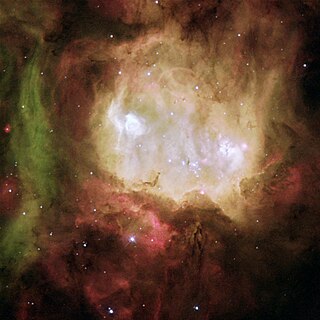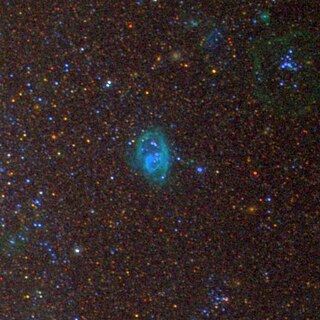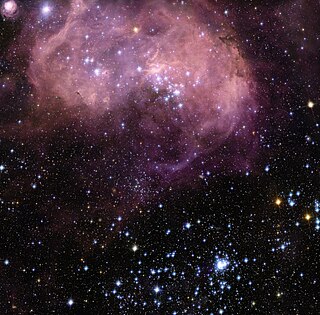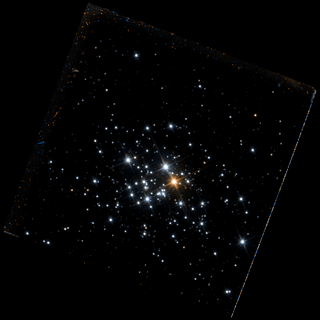
Dorado is a constellation in the Southern Sky. It was named in the late 16th century and is now one of the 88 modern constellations. Its name refers to the dolphinfish, which is known as dorado in Spanish, although it has also been depicted as a swordfish. Dorado contains most of the Large Magellanic Cloud, the remainder being in the constellation Mensa. The South Ecliptic pole also lies within this constellation.

NGC 2080, also known as the Ghost Head Nebula, is a star-forming region and emission nebula to the south of the 30 Doradus (Tarantula) nebula, in the southern constellation Dorado. It belongs to the Large Magellanic Cloud, a satellite galaxy to the Milky Way, which is at a distance of 168,000 light years. NGC 2080 was discovered by John Frederick William Herschel in 1834. The Ghost Head Nebula has a diameter of 50 light-years and is named for the two distinct white patches it possesses, called the "eyes of the ghost". The western patch, called A1, has a bubble in the center which was created by the young, massive star it contains. The eastern patch, called A2, has several young stars in a newly formed cluster, but they are still obscured by their originating dust cloud. Because neither dust cloud has dissipated due to the stellar radiation, astronomers have deduced that both sets of stars formed within the past 10,000 years. These stars together have begun to create a bubble in the nebula with their outpourings of material, called stellar wind.

NGC 2242 is a planetary nebula in the constellation Auriga. It was discovered by Lewis A. Swift on November 24, 1886, and was thought to be a galaxy until a study published in 1987 showed it to be a planetary nebula. The nebula is located about 6,500 light-years away, and about 1,600 light-years above the galactic plane.

NGC 1763 (also known as N11 B, LH 10 or ESO 85-EN20) is an emission nebula with an embedded star cluster in the Dorado constellation in the Large Magellanic Cloud, It is very bright, very large and very irregular. Its apparent size is about 3.0-5.0 arcmin. It is part of a large region of stars called LMC-N11 (N11) which was discovered with a 23-cm telescope by the astronomer James Dunlop in 1826 and was also observed by John Herschel in 1834. The nebula itself is catalogued under LHA 120-N 11B, LH 10 or ESO 85-EN20. It is also part of an area commonly known as the Bean Nebula.

NGC 523, also known as Arp 158, from the ARP catalog is a spiral galaxy located in the constellation Andromeda. It was discovered separately by William Herschel on 13 September 1784, and by Heinrich d'Arrest on 13 August 1862. d'Arrest's discovery was listed as NGC 523, while Herschel's was listed as NGC 537; the two are one and the same. John Dreyer noted in the New General Catalogue that NGC 523 is a double nebula.

NGC 588 is a diffuse nebula located in the outskirts of the galaxy Messier 33, within the Triangulum constellation. It was discovered October 2, 1861 by the German-Danish astronomer Heinrich d'Arrest.

NGC 1858 is a bright, large, irregular open cluster and emission nebula. It is found in the Dorado constellation. It is located in the Large Magellanic Cloud. It was first discovered by James Dunlop on August 3, 1826, and was first recorded as Dunlop 120. John Herschel recorded it on November 2, 1834. However, at the time, he did not associate it with Dunlop 120. Astronomers have now realised that Dunlop 120 and NGC 1858 are the same object.

NGC 2035 is an emission nebula and a H II region in the Dorado constellation and part of the Large Magellanic Cloud. It was discovered by James Dunlop on August 3, 1826. Its apparent size is 3.0.

NGC 2029 is an emission nebula in the Dorado constellation and is part of the Large Magellanic Cloud. It is part of a complex of nebulae and stars, including NGC 2032, NGC 2035 and NGC 2040. It was discovered by James Dunlop on the 27 September 1826. Its apparent magnitude is 12.29, and its size is 2.25 arc minutes.

NGC 1871 is an open cluster associated with an emission nebula located in the Dorado constellation within the Large Magellanic Cloud. It was discovered by James Dunlop on November 5, 1826. Its apparent magnitude is 10.21, and its size is 2.0 arc minutes.

NGC 1873 is an open cluster associated with an emission nebula located in the Dorado constellation within the Large Magellanic Cloud. It was discovered by James Dunlop on September 24, 1826 and rediscovered by John Herschel on January 2, 1837. Its apparent magnitude is 10.4, and its size is 3.50 arc minutes.

NGC 1936 is an emission nebula which is part of the larger LMC-N44 nebula located in the Dorado constellation in the Large Magellanic Cloud. It was discovered by John Herschel in 1834 and added to the Catalogue of Nebulae and Clusters of Stars as NGC 1936. It was later observed by John Dunlop on September 27, 1936 and Williamina Fleming in 1901 and added to the Index Catalogue as IC 2127. Its apparent magnitude is 11.60.

NGC 1935 is an emission nebula which is part of the larger LMC-N44 nebula in the Dorado constellation. NGC 1935 is also located in the Large Magellanic Cloud. It was discovered by John Herschel in 1834 and added to the Catalogue of Nebulae and Clusters of Stars as NGC 1935, then was observed by Williamina Fleming in 1901 and later added to the Index Catalogue as IC 2126.

NGC 1955 is an open cluster associated with an emission nebula located in the Dorado constellation. This nebula is part of the H II region which is part of the Large Magellanic Cloud and was discovered by James Dunlop on August 3, 1826. Its apparent magnitude is 9.0, and its size is 1.8 arc minutes.

N11 is the brightest emission nebula in the north-west part of the Large Magellanic Cloud in the Dorado constellation. The N11 complex is the second largest H II region of that galaxy, the largest being the Tarantula Nebula. It covers an area approximately 6 arc minutes across. It has an elliptical shape and consists of a large bubble, generally clear interstellar area, surrounded by nine large nebulae. It was named by Karl Henize in 1956.

NGC 1983 is an open cluster associated with an emission nebula which is located in the Dorado constellation and part of the Large Magellanic Cloud. It was discovered by John Herschel on 11 November 1836. It has an apparent magnitude of 9.9 and its size is 1.0 arc minutes.

NGC 1980 is a young open cluster associated with an emission nebula in the constellation Orion. It was discovered by William Herschel on 31 January 1786. Its apparent size is 14 × 14 arc minutes and it is located around the star Iota Orionis on the southern tip of the Orion constellation.

NGC 1984 is an open cluster associated with an emission nebula, it is located in the constellation Dorado in the Large Magellanic Cloud. It was discovered by John Herschel on 16 December 1835. The apparent magnitude is 9.9 and its size is 1.50 by 1.20 arc minutes.

NGC 1255 is a barred spiral galaxy approximately 69 million light-years away from Earth in the constellation of Fornax.


















